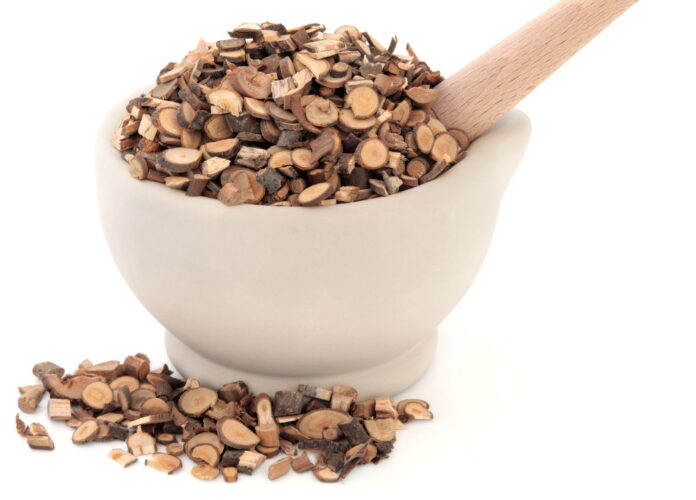By Hyunchang Cho, L.Ac., Ph.D
I explained TEM is a systemic procedure to find a formula by a symptom, body type, and CAPE earlier. This month, I will show a practical way to find a formula by using guiding herbs like Gui Zhi.
Gui Zhi
Symptom Indicator Score+++
Frequency of Use+++
Gui Zhi patients are prone to feeling cold. They check yes to most of the questions regarding Cold in the DPHF Chart.
Clinical Expressions → Taken from the Cold/Heat part of the DPHF Chart
Easily feels cold more often than others. Prone to feeling cold.
(hands, feet, or other body parts) are cold. It’s very cold and sometimes freezingly cold.
Main Symptoms
Cold intolerance: Easily feels cold ☞Body Temperature Scale: around 5
Parts of the body (i.e., hands or feet) are cold and freezing/icy cold in severe cases.
Upper Heat (hot flushes) is often accompanied.
Possible Symptoms
Body aches that are aggravated by cold and relieved by heat. After sleeping or shivering in a cold place or before period, body aches accompanied by an aversion to wind, and mild fever may occur.
Headaches
Tip You can consider Gui Zhi after ruling out Wu Zhu Yu and Fu Zi. Cold intolerance and coldness of the limbs combined with Upper Heat are highly indicative of Gui Zhi.
Pharmacological Hypothesis of Gui Zhi
|
Increased peripheral vasodilation of the target area→improved peripheral circulation → enhanced thermogenesis and metabolism |
||||
|
↓ |
↓ |
↓ |
↓ |
↓ |
|
Increased peripheral vasodilation of the body surface →improved peripheral circulation →enhanced body surface temperature |
Increased dilation of the coronary artery → improved blood circulation of the heart →cardiotonic effect |
Increased GI tract vasodilation→improved blood circulation of the area → enhanced core body temperature, and resultant improvement of digestive function |
Increased urogenital vasodilation→ improved blood circulation of the area → enhanced core body temperature, and resultant dissolution of blood stasis |
Increased glomerular vasodilation→enhanced the diuretic effect |
|
↓ |
↓ |
↓ |
↓ |
↓ |
|
Gui Zhi formulas for treating the body surface (musculoskeletal pain) : Gui Zhi Tang, Ma Huang Tang |
Gui Zhi formulas for treating the heart : Gui Zhi Gan Cao Tang, Gui Zhi Qu Shao Yao Tang, Zhi Shi Xie Bai Gui Zhi Tang, Mu Fang Ji Tang, and such |
Gui Zhi formulas for treating the GI tract : Huang Lian Tang, Liu Wu Huang Qin Tang, and such |
Gui Zhi formulas for removing blood stasis : Gui Zhi Fu Ling Wan, Tao Ren Cheng Qi Tang and such |
Gui Zhi formulas for treating the urogenital area : Wu Ling San, Fu Ling Ze Xie Tang, Ba Wei Wan and such |
|
↓ |
↓ |
↓ |
↓ |
↓ |
|
Resulting as clinical signs (expressions) of Gui Zhi: Cold intolerance, coldness of the limbs, Upper Heat, heart palpitations, body aches, fever, headaches, and such |
||||
Gui Zhi seems to have a peripheral vasodilating effect on the target site, increasing blood circulation and body temperature.
When the target area is the body surface, as in Gui Zhi Tang formulas and Ma Huang Tang formulas, Gui Zhi seems to increase the peripheral vasodilation of the surface, thus enhancing blood circulation and body temperature.
Gui Zhi treats cold sensations of the body and musculoskeletal pain in clinical practice due to decreased blood circulation and surface temperature. Also, Gui Zhi has antipyretic and sweat-inducing effects for infections of external origin such as the common cold and influenza.
When the target area is the internal organs of the chest and abdominal cavities, Gui Zhi seems to improve the blood circulation of the target area through vasodilating effects.
When the target area is the heart, as in the cases of Gui Zhi Gan Cao Tang formulas, Gui Zhi Qu Shao Yao formulas, Mu Fang Ji Tang, Zhi Shi Xie Bai Gui Zhi Tang, and such, Gui Zhi seems to have cardiotonic effects through vasodilation of the cardiac arteries, thus enhancing the blood circulation of the cardiac area.
When the target area is the GI tract, as in the cases of Huang Liang Tang, Liu Wu Huang Qin Tang, and such, Gui Zhi seems to enhance blood circulation of the gastric area through vasodilating effects, thus increasing the core temperature of the digestive system and improving its functions.
When Gui Zhi is used to treat blood stagnation, as in the cases of Gui Zhi Fu Ling Wan, Tao Ren Cheng Qi Tang, and such, Gui Zhi seems to enhance blood circulation of the urogenital area through vasodilating effects, thus increasing the core temperature of the urogenital system and help to dissolve stagnated blood (stagnated blood).
When the target area is the urinary system, as in the cases of Wu Ling San, Fu Ling Ze Xie Tang, Ba Wei Wan, and such, Gui Zhi seems to have vasodilating effects on the glomerulus, resulting in enhanced diuretic effects.

































